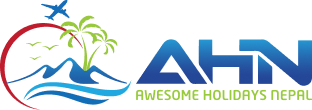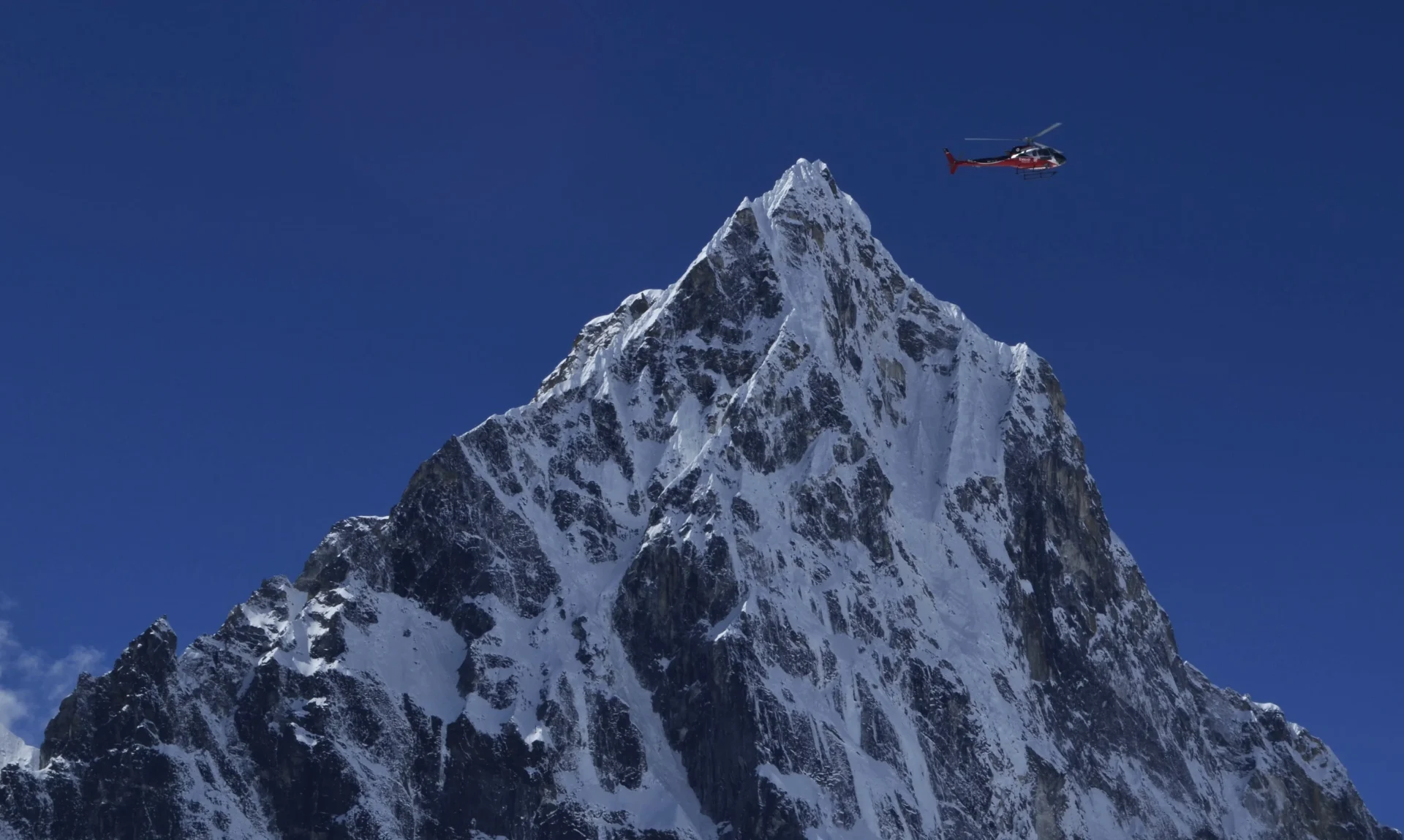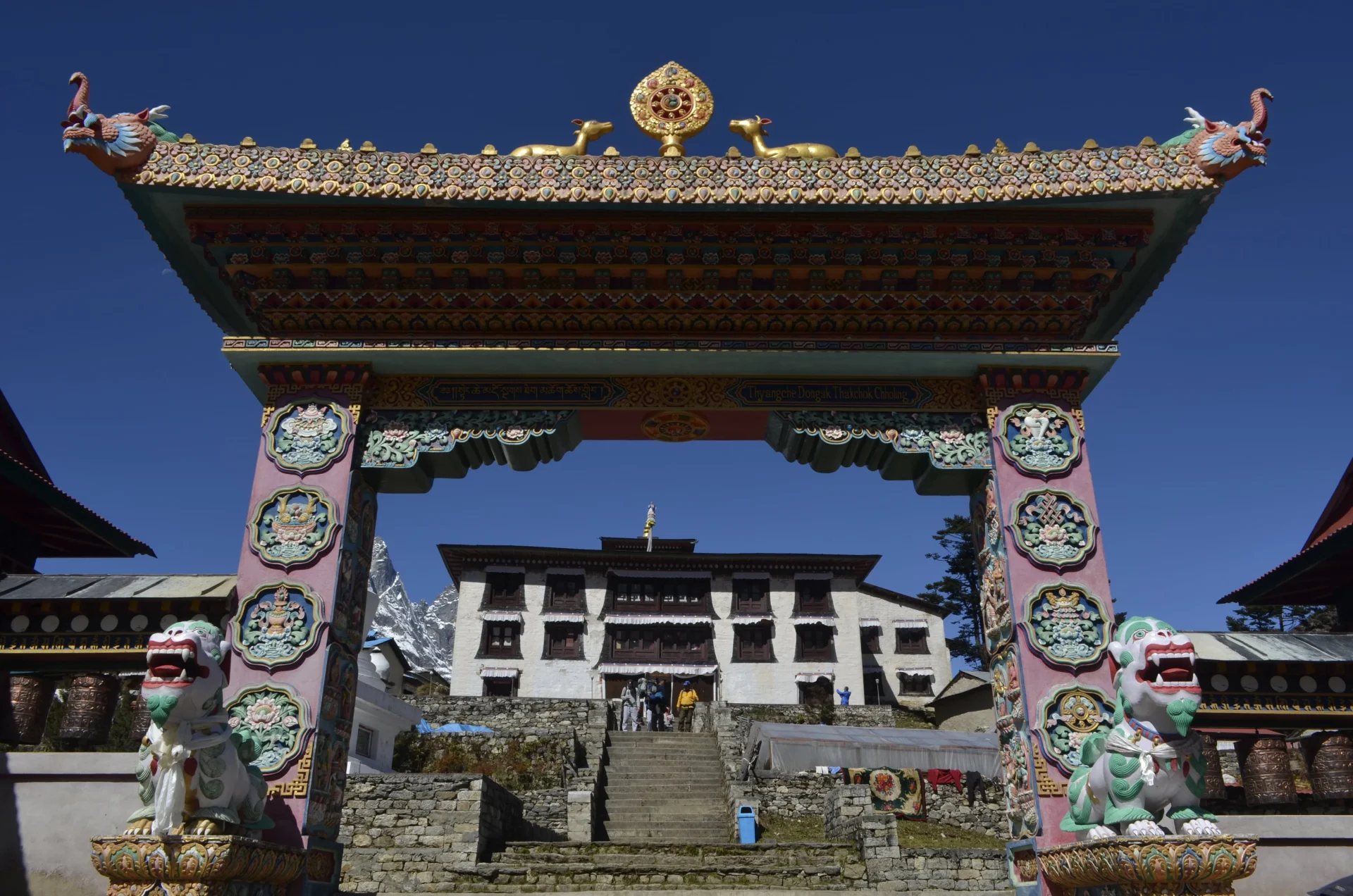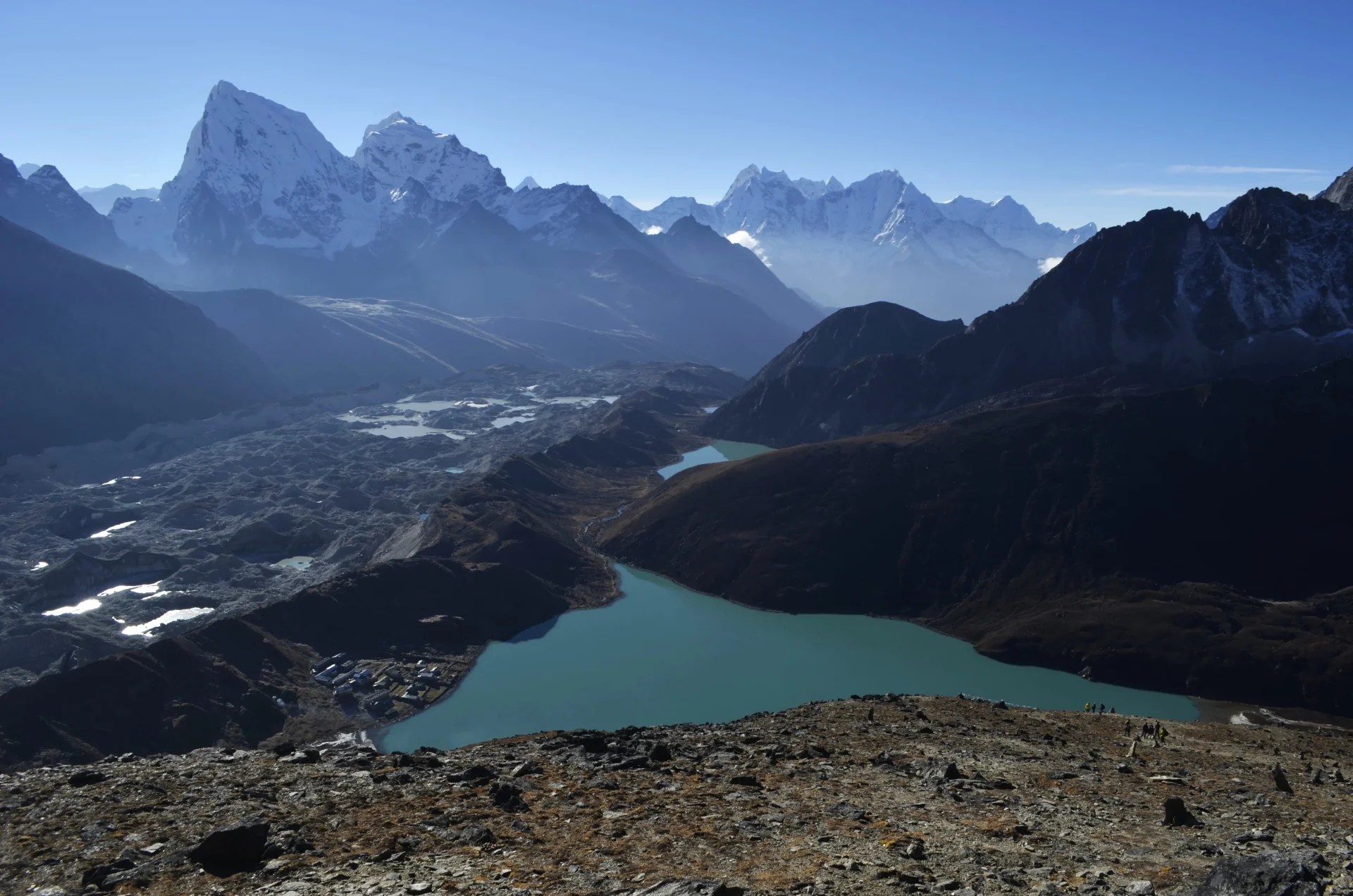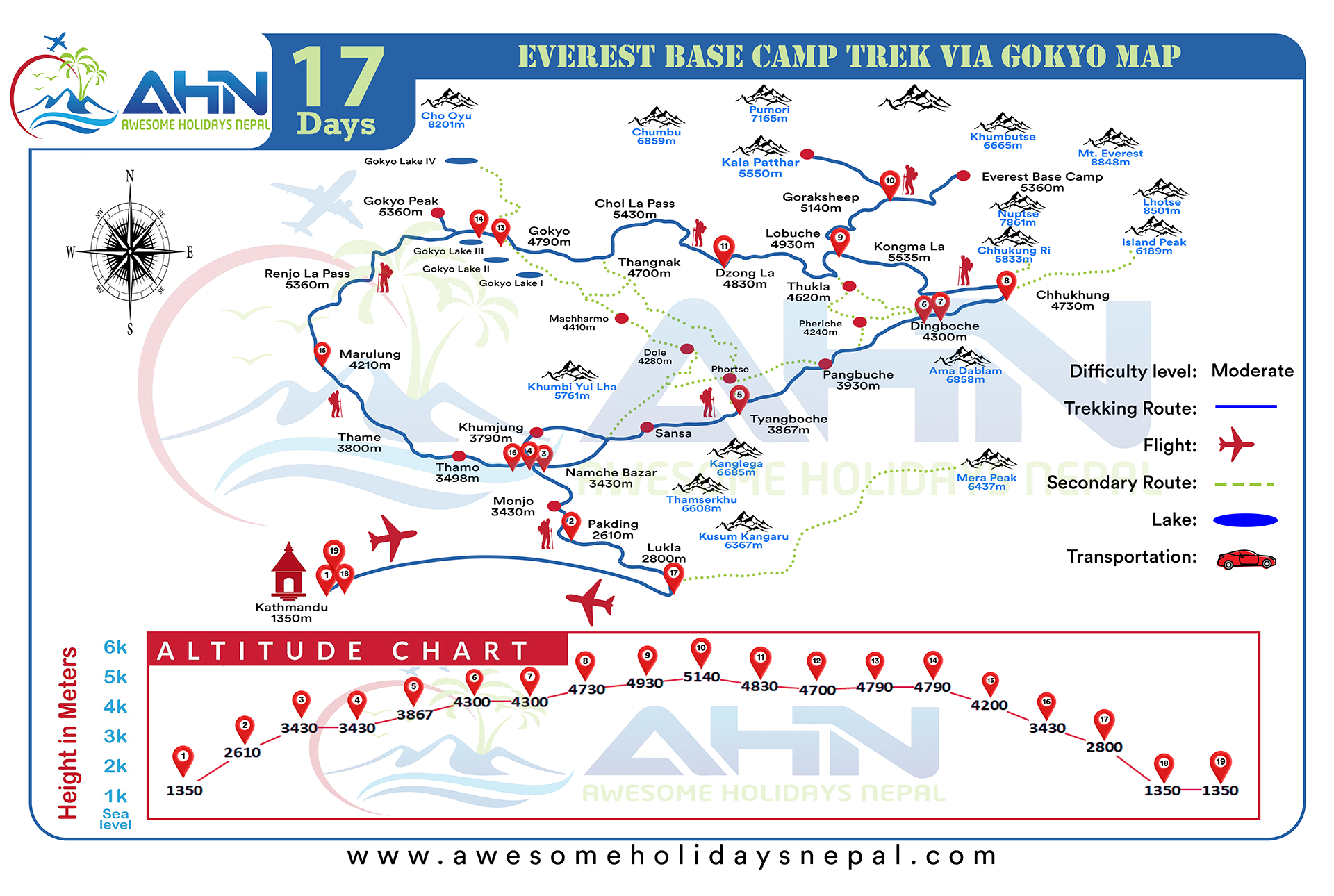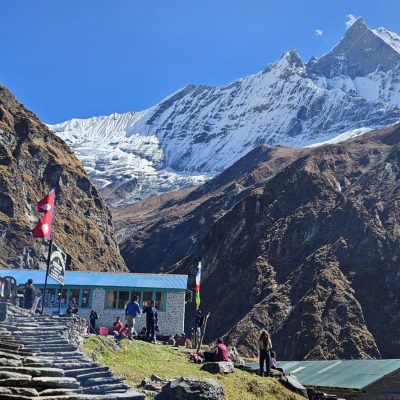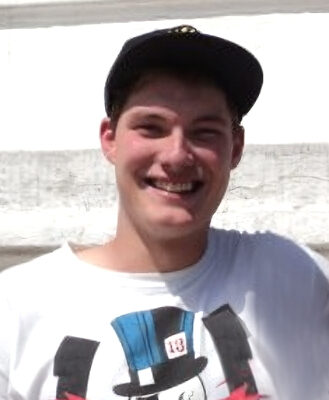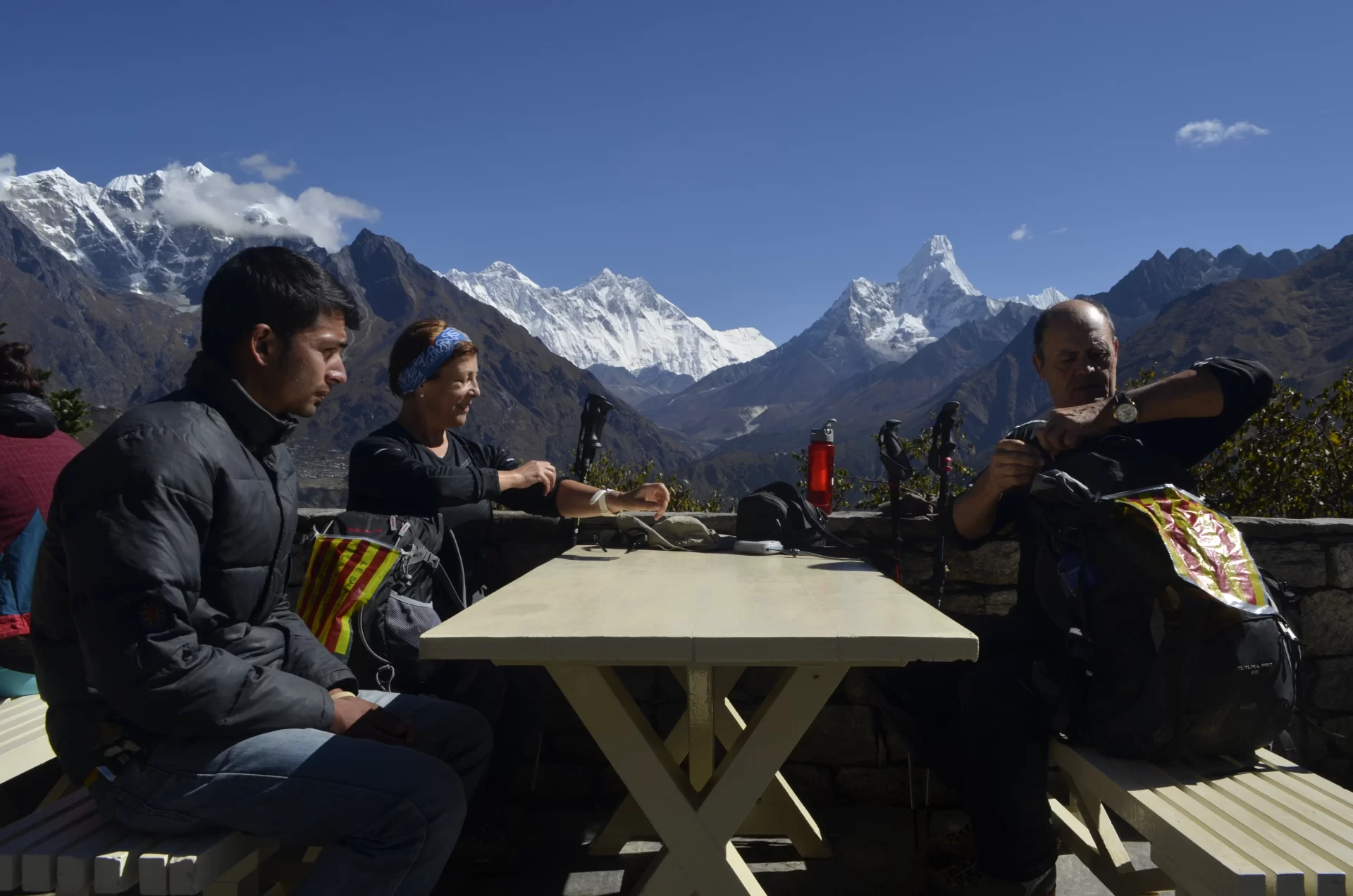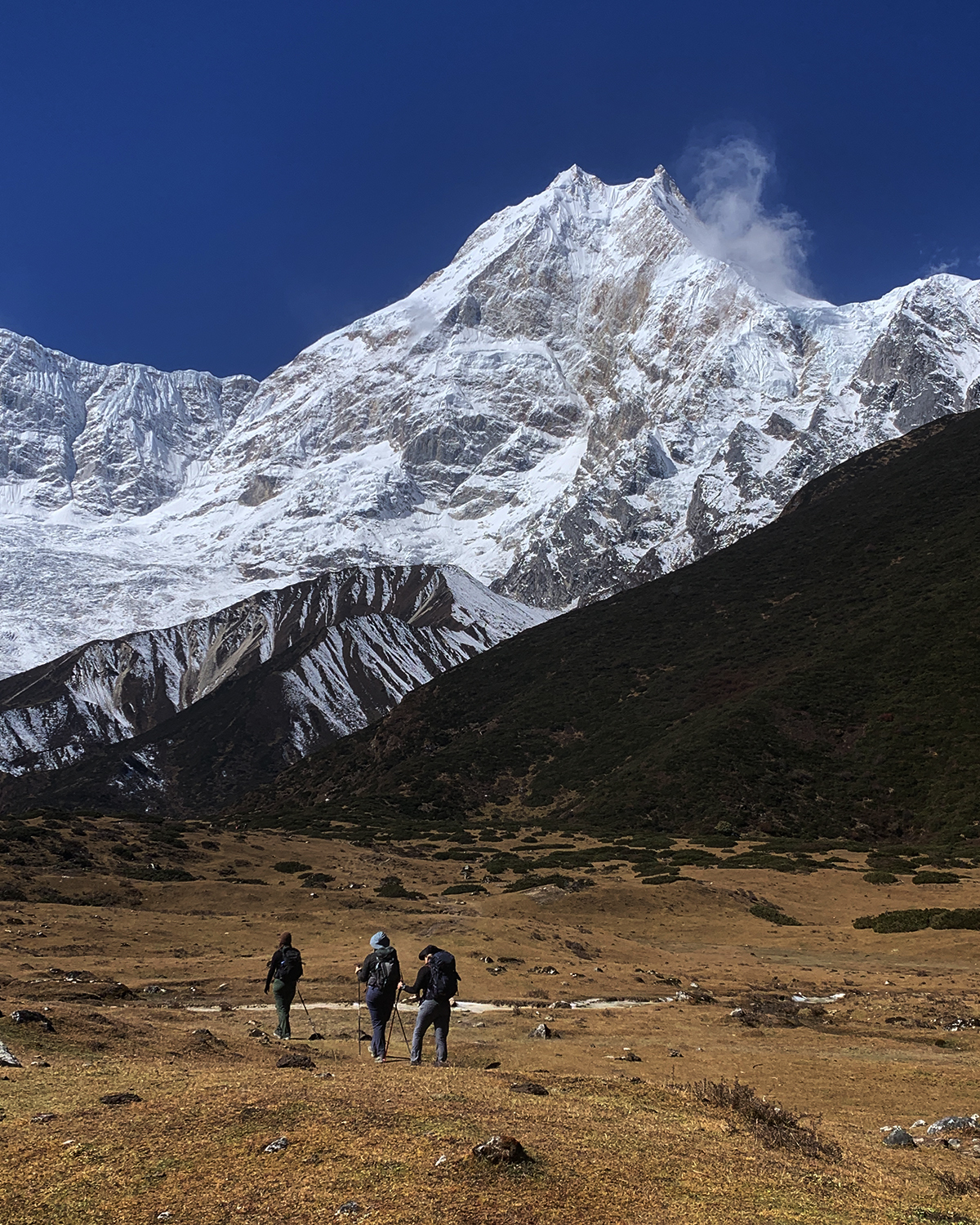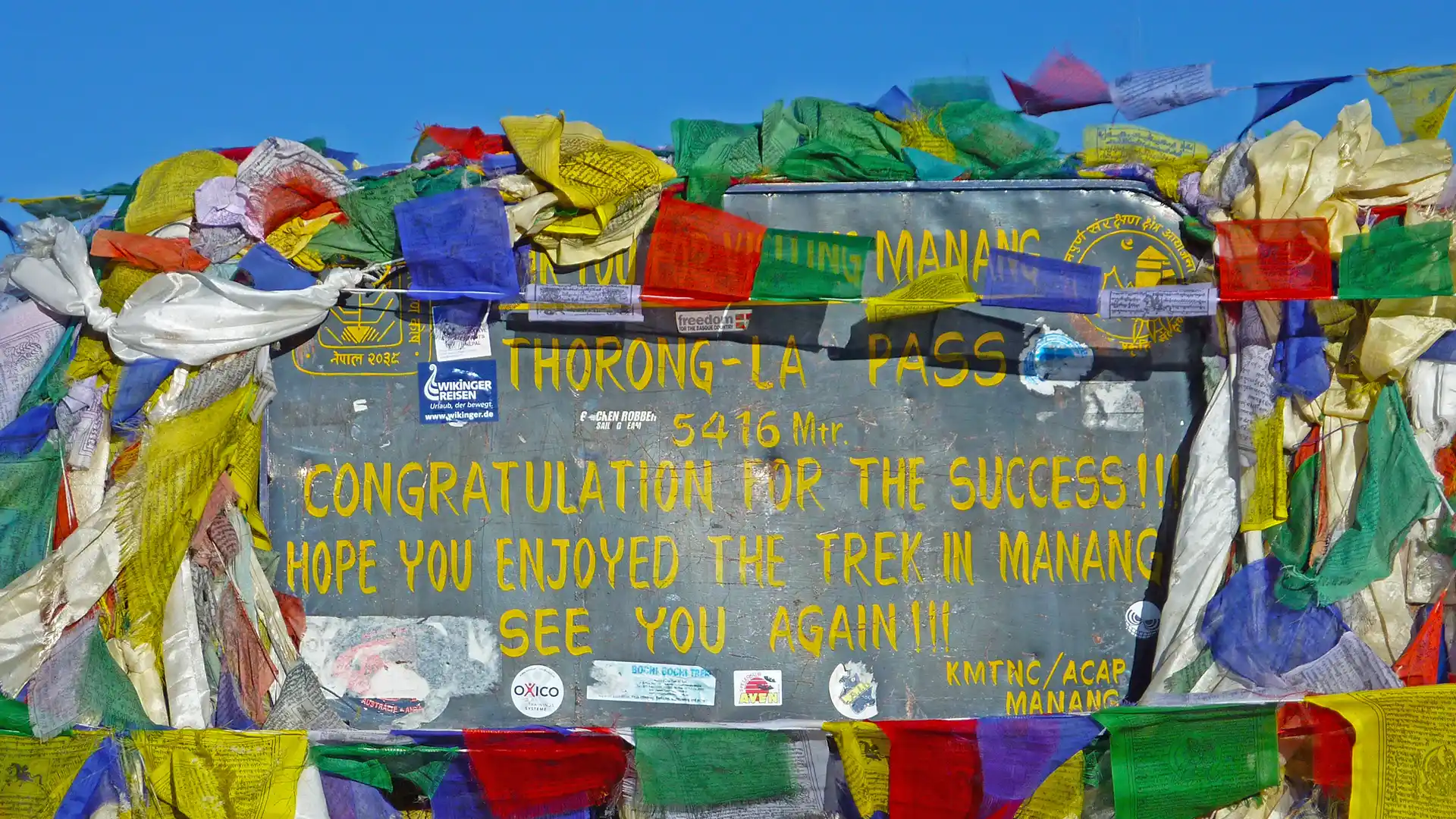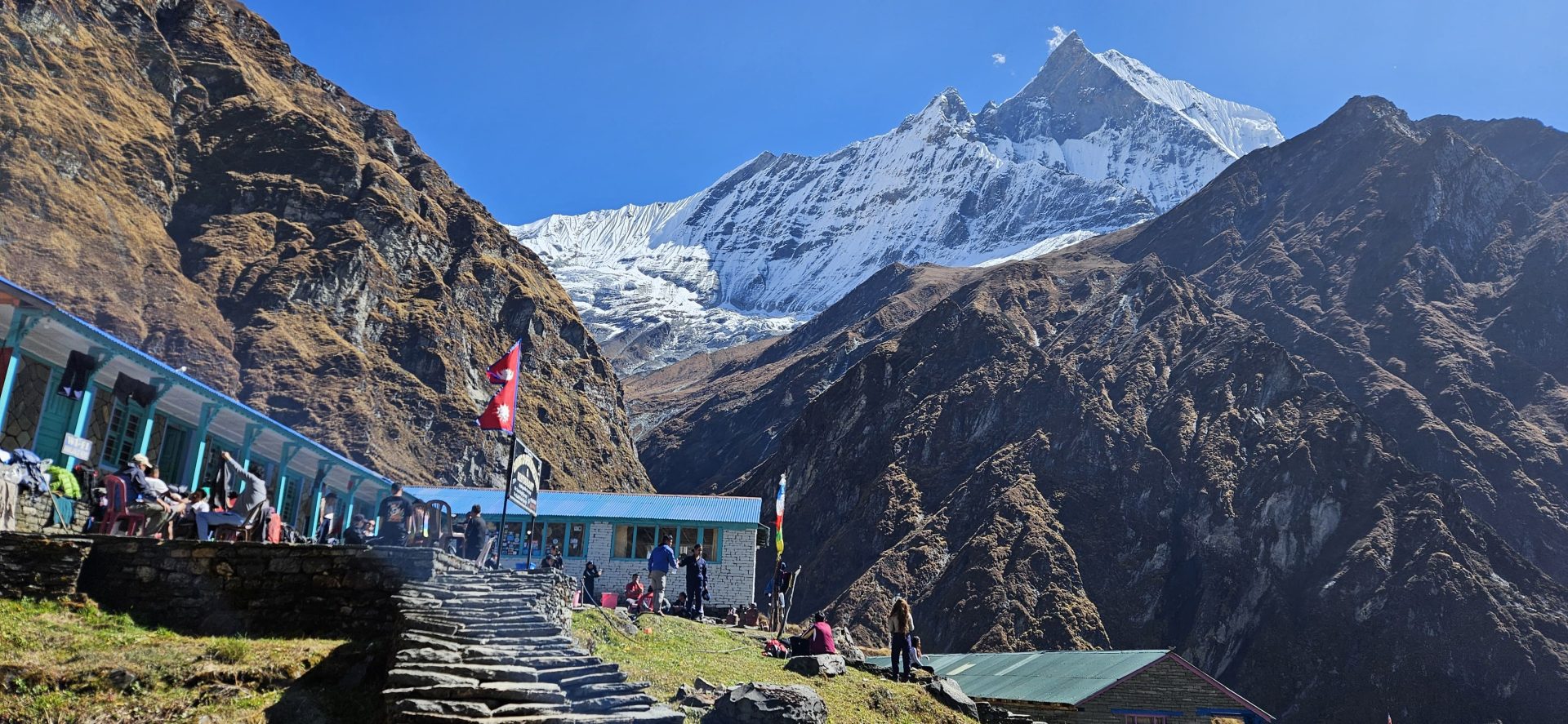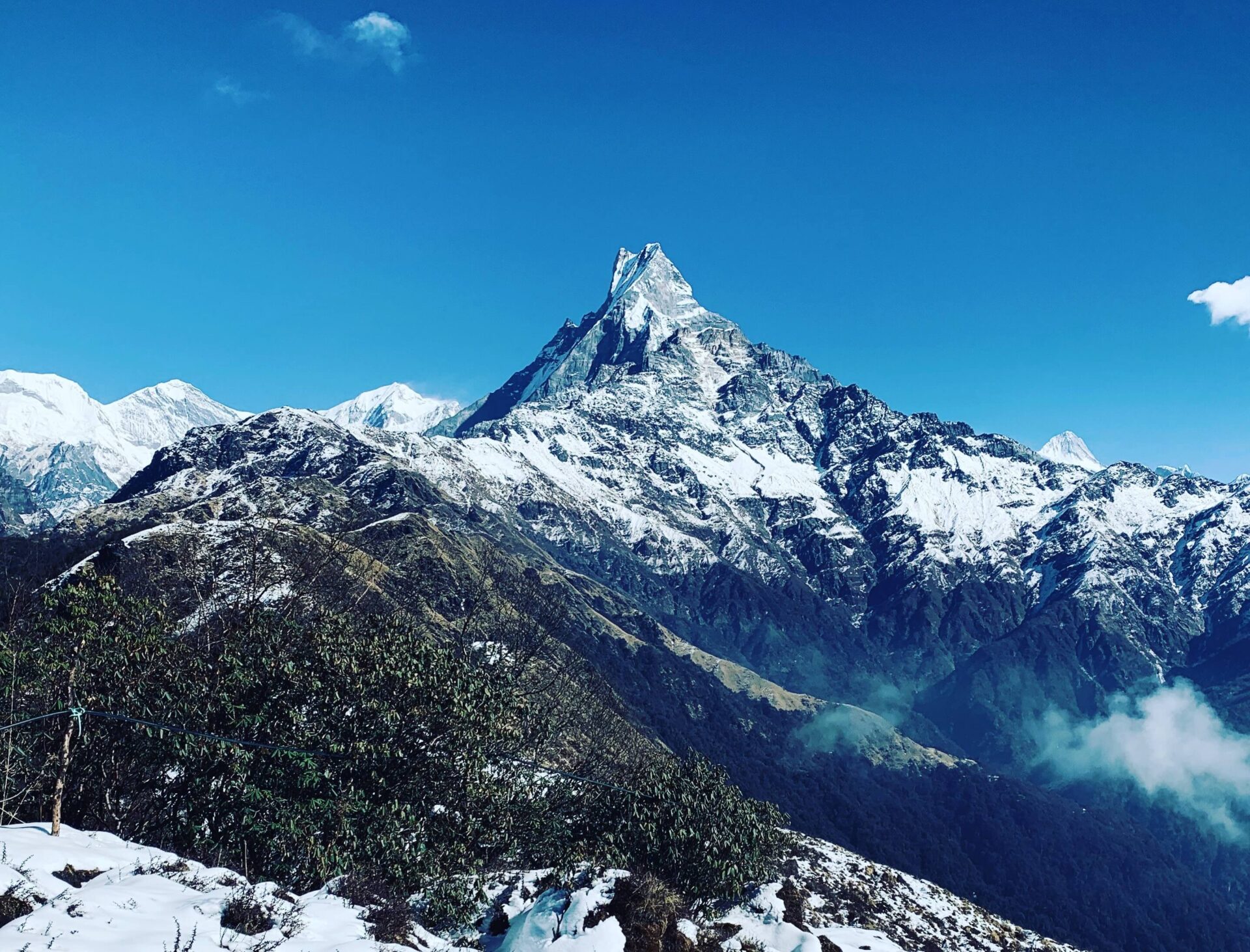Explore the stunning mountain ranges through high mountain passes of the Everest region. The challenging three-pass trek is a 17-day adventure that begins with a thrilling flight and takes you through some fascinating landscapes.
Everest Three-Pass Trek overview
The Everest Three Pass trek is one of the most thrilling experiences for polished trekkers who visit Nepal for challenging adventures. This 17-day trek begins with a scenic flight to Lukla and takes you through mainstream attractions of the Everest region before finally leading to the three higher passes of Everest. The three high passes of the world’s highest peak, Renjo La, Cho La, and Kongma La, are situated at an elevation of 5360 meters, 5420 meters, and 5535 meters from ground level and present a breathtaking view of the high mountain peaks.
Offering an unparalleled blend of natural beauty, cultural immersion, and personal challenge, this challenging trek takes you through the rich culture of the Sherpa capital of Namche Bazaar and the decades-old heritages of Himalaya villages like Tengboche and Dingboche. From Lukla, we will trek to Phakding, passing through diverse landscapes and charming villages, and then reach Namche Bazaar, where you will get to learn about Sherpa traditions and local lifestyle. You will also get a chance to see the rich and unique biodiversity of Sagarmatha National Park, a UNESCO World Heritage site that includes animals like snow leopards, musk deer, Himalayan tahr, snow cock, blood pheasant, etc.
As you ascend through the Himalayan villages and rugged terrain, you’ll be rewarded with panoramic views of Everest, Lhotse, Nuptse, and Ama Dablam. The Everest View Hotel is a very popular stop on the route to enjoy the stunning view of snow-covered Mount Everest. Perching through these challenging trails and stops like Tengboche, Dingboche, Nagarjuna, and Lobuche, you will come across the first of the three passes, the Kongma La pass. After enjoying this view, we will move towards the Everest Base Camp and enjoy the view of Khumbu Icefall before returning back to Gorakshep for the next day’s adventure. On our way back, we will hike to Kalapathar and witness the beautiful alpine landscapes. Continuing the trek, we will reach Cho la Pass and then come across the Gokyo Lake before the final Renjo La Pass. This trek can be done in both clockwise and anti-clockwise directions.
Everest Three-Pass Trek Key Attractions
- Scenic flight from Kathmandu to Lukla, with stunning aerial views of the Himalayas.
- Trekking through the diverse landscapes of Sagarmatha National Park, a UNESCO World Heritage site.
- Cultural immersion in Namche Bazaar, the bustling Sherpa town and gateway to Everest.
- Visit Tengboche Monastery, the spiritual center of the Khumbu region, with breathtaking views of Everest and Ama Dablam.
- Acclimatization days in Namche Bazaar and Dingboche, offering hikes to nearby viewpoints with panoramic vistas.
- Trek to the three highest passes of Everest, Kongma La Pass (5535 meters), Renjo La Pass (5360 meters), and Cho La Pass (5420 meters).
- Panoramic views of the Everest from Kalapathar and Everest View Hotel, the highest one in the Khumbu region.
- A chance to encounter the rich biodiversity of the Sagarmatha National Park in the Everest region.
Everest Three-Pass Trek Itinerary
Expand AllArrival in Kathmandu
Upon arrival at Tribhuvan International Airport in Kathmandu, you will be greeted by our representative and transferred to the hotel. One of the vibrant cultures of Nepal will be introduced to you through a welcome dinner at one of the typical Nepali restaurants with a cultural show. During dinnertime, there will be a briefing about your trek details, giving an idea of the thrilling journey ahead in Nepal. This introduction is supposed to set the tone for your adventure, filled with cultural exploration and excitement about what lies ahead.
Fly to Lukla and Trek to Phakding
Early in the morning, we will catch a flight to Lukla, which offers a panoramic view of the beautiful Himalayan ranges. After landing in Lukla, we will trek to Phakding through various landscapes and charming villages. You will have your first trekking experience in this beautiful territory rich in nature and culture. The flight will take 45 minutes as soon as it takes from Kathmandu, and hiking to Phakding will take around 3.5 hours. Spend the night in Phakding and acclimate to the Himalayan breeze to begin your adventurous journey ahead in Nepal.
Trek from Phakding to Namche Bazaar
Starting the trek from Phakding, we will pass the Dudh Koshi River and cross a few suspension bridges adorned with prayer flags of bright colors. We will pass through Sagarmatha National Park, a UNESCO World Heritage site full of natural beauty. You will witness wide views of the surrounding peaks as you trek further up to the Sherpa town and principal center of the Everest region, Namche Bazaar. The day offers a cultural experience and excellent scenery in the trek to Everest Base Camp. After trekking for about 7 hours, we will rest out the day at Namche Bazaar while enjoying the Sherpa food, tradition, and hospitality.
Trek to Hotel Everest View and Back to Namche
Next day, we will go on a round trek from Namche Bazaar to the Hotel Everest View, one of the best locations to enjoy the fascinating 360-degree view of the peak of the world. Located at an elevation of 13000 feet from sea level, the resort is well-known for offering fascinating mountain views to every visitor who trek or trek to the Everest region. In fact, you can catch the panoramic vista of Everest and the beautiful sight of the Khumbu Valley. After soaking in the exceptional sight of snow-capped peaks and its surroundings, we hike back to Namche. This round trip takes around 3 hours to complete.
Trek to Tengboche then Dibuche
The following day, we will trek from Namche Bazaar to Tengboche, where you can savor stupendous views of Everest, Nuptse, and Ama Dablam. Walk through dense and luscious rhododendron forests, the trail adding color splashes to your trek by lighting up in a flush of red. As you approach Tengboche, you can expect to meet the quiet and spiritual ambiance of the famous Tengboche Monastery, set with stunning backdrops of the Himalayas. You will witness how beauty meets cultural discovery for a serene and magnificent experience amongst mountains. Continuing the trek, we will move towards Dibuche, which will be our stop for the day. Since the trek takes about 6 hours, we will enjoy dinner and rest for the next day’s journey.
Dibuche to Dingboche
Moving forward, we will continue the trek from Dibuche to Dingboche, crossing trails through the most varied landscapes. After trekking past the forests and across the Imja Khola river, first descend and then ascend in another climb to the traditional village of Pangboche. Going even higher, one comes to Dingboche, within the wonderful Imja Valley. This area provides stunning views of Lhotse, Ama Dablam, and Island Peak, offering an incredible vista on your journey to Nepal. The trek will take about 7 hours to complete, which will certainly tire you out, so we will rest out for the day and keep exploring this Sherpa village for the next day.
Trek to Nagarjuna and Return to Dingboche
The next day, we will begin a challenging trek to Nagarjuna from Dingboche while passing through hard routes in a slow ascend amidst shrub landscapes. You catch fantastic views of the Khumbu Glacier, which forms another high point on your Everest journey at high altitudes. After climbing over rocky terrain, you will reach Lobuche, a small place close to the tall peaks. Because of the heavy rigors and thinning air, this segment of your trek toward the Everest Base Camp will become challenging but highly rewarding. You will reach the top of Nagarjuna Hill and trek back to Dingboche after a tiring 5 hours journey. This day captures the essence of your Nepal adventure: physical challenge and breathtaking natural beauty.
Dingboche to Chhukung
To get closer to the high mountain pass, we trekked from Dingboche to Chhukung village. Chhukung village houses Chhukung Ri, a rocky premium peak that extends along the Mahalangur sub-range. In fact, the rocky Chhukung Peak is a mandatory stop for adventurers who are fascinated by peak climbing. It is well known for being a challenging ascent that offers stunning views and often helps climbers acclimatize before climbing the nearby Island peak. We will stay in the village after trekking for 4 hours.
Chhukung to Lobuche via Kongma La Pass
After passing through 5546 meters of Chhukung Ri, we will march towards the Kongma La Pass, one of the high mountain passes. The Kongma La pass is at an elevation of 5535 meters from sea level and offers a mesmerizing sight of the south face of Everest. Actually, you can reach this pass through two different trails; one takes you to Bibre and lets you trail over the Niyang Khola, whereas the other takes you to the northwestern side of Chhukung and over the Nuptse Glacier moraines. Either of the trails will take you about 8 hours to reach the pass and then to Lobuche. Since no food and accommodation are available at the Kongma La pass, it is necessary to reach Lobuche by sunset to rest.
Lobuche to Gorakshep via EBC to Gorakshep
Continuing the trek from Lobuche, we start trekking from Lobuche to Gorak Shep, our last stop, before reaching Everest Base Camp. After a short rest in Gorak Shep, we’ll continue our journey to Everest Base Camp, where climbers gather before attempting to summit the world’s highest peak. Here, we’ll take in the awe-inspiring views of the Khumbu Icefall and the surrounding Himalayan giants. After soaking in the breathtaking scenery, we’ll return to Gorak Shep for an overnight stay, which marks a significant milestone in our Everest Base Camp trek and overall Nepal adventure. This round trip will take a total of 9 hours, starting from Lobuche and ending at Gorakshep.
Hike to Kalapathar, Get Back to Gorakshep, and Hike to Dzongla
Our day begins with an early morning hike to Kala Patthar, where we’ll witness a stunning sunrise over Everest and the surrounding peaks. This viewpoint offers the most spectacular views of Everest and the Khumbu Glacier, making it one of the highlights of our trek. After taking in the breathtaking scenery, we’ll descend to Gorak Shep for breakfast before continuing our trek to Dzongla. As we journey through beautiful alpine landscapes, we’ll have time to reflect on the incredible experiences of our Everest Base Camp trek, making this a rewarding day in our Nepal adventure. This round trip to the mighty rocks of Kalapathar and back to Gorakshep day and then hiking to Dzongla will take about 7 hours.
Dzongla to Thagnak via Cho la Pass
On this day, we will wake up early and march towards the journey of another high mountain pass, the Cho La Pass. We will begin this journey from Dzongla and try to reach the Cho La pass as early as possible, as it would be difficult to walk on a glacier if there is too much snow. After enjoying the captivating mountain view from this second-highest pass at 5420 meters from sea level, we will continue the trek towards Thagnak and stay overnight at a local teahouse. It will take around 9 hours to complete this whole trek.
Trek from Thagnak to Gokyo Lake
On this day, we will have a rather short trek to enjoy the turquoise blue waters of Gokyo Lake, situated at an elevation of 5000 meters from sea level. We will wake up well-rested, have breakfast, and trek to Gokyo Valley, where we will take a short stop for lunch and explore the surroundings. From the valley, you will be able to view Mount Everest, Lhotse, Makalu, Mount Cho Oyu, and other peaks of the Khumbu region. After trekking for about 3 hours, we will be able to reach Gokyo from Thagnak, and in the remaining time, you can rest and explore the premises.
Gokyo Lake to Gokyo Ri and Back to Lake
To better enjoy the lake view, we will ascend from our tea house accommodation around Gokyo Lake to Gokyo Ri, located at an elevation of 5483 meters from sea level. This 5-hour round trek will offer a fantastic view of the turquoise water of Gokyo Lake, the Gokyo Valley, and a panoramic view of all the surrounding peaks of the Everest region. You will also be able to catch sight of the massive Ngozumpa glacier from the top of Gokyo Ri.
Gokyo Lake to Lunden via Renjo La Pass
After a chilled day, we have the last mountain pass on our list of destinations for the day. We will wake up early and have breakfast to prep for an 8-hour trek. Starting from Gokyo, we will descend down to Lunden, passing the 5360-meter-high Renjo La pass. Like other mountain passes, this one also offers captivating mountain views, including the north face of Everest, Mount Makalu, and Mount Lhotse.
Lunden to Namche Bazaar
Wrapping up our challenging trek to all three high mountain passes, we will descend down to Namche Bazar on this day. This trek will take about 6 hours, passing through Khumjung village at Mount Ama Dablam’s base. After arrival, we will rest for a few hours, and later in the evening, you can explore this Sherpa settlement. Namche Bazaar is a good place to shop for souvenirs and has many good markets just for a stroll too.
Trek Down to Phakding and to Lukla
On our final trekking day, we’ll continue our descent from Namche Bazaar to Phakding and then Lukla, passing through the familiar lush landscapes that have become a part of our Everest adventure. As we return, we’ll feel a deep sense of accomplishment, having completed this incredible journey. Upon arriving in Lukla, we’ll take a moment to bid farewell to the Everest region and prepare for our flight back to Kathmandu, marking the conclusion of our unforgettable Nepal trip. This trek will take about 8 hours to complete, starting right away after the morning breakfast. We will stay in Lukla that day to catch a flight early the next day.
Fly Back to Kathmandu
We’ll start our day with an early morning flight from Lukla to Kathmandu, where we’ll again be treated to scenic views of the Himalayas—a final reminder of our incredible journey. Upon arrival in Kathmandu, we’ll transfer to our hotel and enjoy a day of relaxation or take the opportunity to explore more of the city’s vibrant culture and attractions. This day marks a peaceful and reflective end to our Nepal adventure, allowing us to unwind after our trek.
Departure from Kathmandu
As our Nepal trip concludes, we may have some free time before departure for last-minute shopping or a final stroll through Kathmandu. Our representative will then transfer us to the airport for our flight, ending our unforgettable Everest three-pass trek and Nepal vacation. We’ll depart with memories of breathtaking landscapes, vibrant culture, and the adventure of a lifetime.
Everest Three-Pass Trek Cost Includes
- Airport pickup and drop off (both domestic and international)
- Welcome/Farewell dinner at Kathmandu.
- 2 Night accomodation in Kathmandu (3 star standard hotel)
- 1 English speaking professional guide for entire trek days
- 1 Porter to carry your duffel bag. 2:1 ratio for Guest to Porter
- Kathmandu-Lukla or Ramechhap Airfare
- Lukla-Ramechhap or Kathmandu airfare
- Stay at teahouses/ guest houses on the trek on a twin-sharing basis (single room available with an extra charge)
- Standard meals during the trek include Breakfast, Lunch, and Dinner.
- All meals and insurance for support staff, Leader, porters and assistant guides
- Purifies drinking water during the trek using a water purifier or chemical purifying tablets.
- All necessary permits for the Everest three-pass trek.
- First-aid treatment in case of any emergencies.
- All administrative expenses and government taxes.
Everest Three-Pass Trek Cost Excludes
- Meals in Kathmandu except for the welcome/farewell dinner (can be arranged on request with additional charge)
- International flight fares and airport departure tax.
- Bottled water or any beverage.
- Tourist visa for entry in Nepal.
- Travel insurance and the emergency evacuation service charges.
- Personal expenses, including personal gear or equipment.
- Tipping and Gratuities for Trek Leaders, Assistants and Porter
Everest Three-Pass Trek Extra Information
As peak climbing seasons (March-May and October-November) often have extended air traffic, the flight to Lukla will take off from Ramechhap/Manthali airport instead of Kathmandu airport. This alternative airport is approximately 6 hours’ drive from Kathmandu.
Meanwhile, the flight will take off from the Kathmandu Airport in other seasons.
Everest Three-Pass Trek date and time
Select a Departure Month
| Dates | Availability | Price |
|---|
| Dates | Availability | Price |
|---|
| Dates | Availability | Price |
|---|
| Dates | Availability | Price |
|---|
| Dates | Availability | Price | ||
|---|---|---|---|---|
|
From: Fri, 20th Jun, 2025 To: Mon, 7th Jul, 2025 | On Sale |
Available |
| Join now |
| Dates | Availability | Price | ||
|---|---|---|---|---|
|
From: Fri, 11th Jul, 2025 To: Mon, 28th Jul, 2025 | On Sale |
Available |
| Join now |
| Dates | Availability | Price | ||
|---|---|---|---|---|
|
From: Fri, 5th Sep, 2025 To: Mon, 22nd Sep, 2025 |
Available |
US$ 2160 | Join now | |
|
From: Fri, 12th Sep, 2025 To: Mon, 29th Sep, 2025 |
Available |
US$ 2160 | Join now | |
|
From: Fri, 19th Sep, 2025 To: Mon, 6th Oct, 2025 |
Available |
US$ 2160 | Join now | |
|
From: Fri, 26th Sep, 2025 To: Mon, 13th Oct, 2025 |
Available |
US$ 2160 | Join now |
| Dates | Availability | Price | ||
|---|---|---|---|---|
|
From: Fri, 3rd Oct, 2025 To: Mon, 20th Oct, 2025 |
Available |
US$ 2160 | Join now | |
|
From: Fri, 10th Oct, 2025 To: Mon, 27th Oct, 2025 |
Available |
US$ 2160 | Join now | |
|
From: Fri, 17th Oct, 2025 To: Mon, 3rd Nov, 2025 |
Available |
US$ 2160 | Join now | |
|
From: Fri, 24th Oct, 2025 To: Mon, 10th Nov, 2025 |
Available |
US$ 2160 | Join now | |
|
From: Fri, 31st Oct, 2025 To: Mon, 17th Nov, 2025 |
Available |
US$ 2160 | Join now |
| Dates | Availability | Price | ||
|---|---|---|---|---|
|
From: Fri, 7th Nov, 2025 To: Mon, 24th Nov, 2025 |
Available |
US$ 2160 | Join now | |
|
From: Fri, 14th Nov, 2025 To: Mon, 1st Dec, 2025 |
Available |
US$ 2160 | Join now | |
|
From: Fri, 21st Nov, 2025 To: Mon, 8th Dec, 2025 |
Available |
US$ 2160 | Join now | |
|
From: Fri, 28th Nov, 2025 To: Mon, 15th Dec, 2025 |
Available |
US$ 2160 | Join now |
| Dates | Availability | Price | ||
|---|---|---|---|---|
|
From: Fri, 5th Dec, 2025 To: Mon, 22nd Dec, 2025 |
Available |
US$ 2160 | Join now | |
|
From: Fri, 12th Dec, 2025 To: Mon, 29th Dec, 2025 |
Available |
US$ 2160 | Join now | |
|
From: Fri, 19th Dec, 2025 To: Mon, 5th Jan, 2026 |
Available |
US$ 2160 | Join now | |
|
From: Fri, 26th Dec, 2025 To: Mon, 12th Jan, 2026 |
Available |
US$ 2160 | Join now |
| Dates | Price | Availability |
|---|---|---|
|
Select Date:
Please select the date |
US$ 1990 |
Packing List for Everest Three-Pass Trek
The key is to prioritize lightweight, durable, and versatile gear. It's important to test and familiarize yourself with your equipment before embarking on a trek. If you find a particular brand that meets your criteria for quality, that's great, but always prioritize functionality and reliability.
General
- Sleeping bags (zero degrees)
- Backpack with rain cover (recommended size about 35-45 liters)
- Sleeping bag liner
- Duffel Bag (can be rented)
Basic Clothing
- Warmers and technical fabric base layer
- Comfortable pants
- Sleeping wear/night suits
- Undergarments & sports bra
Warm Clothes
- Body warmer tops and pants
- Fleece jacket/pullovers
- Warm pants
- Wool or technical fabric
- Hard shell outer gloves
- Warm caps/Knitted hats
Feet protection
- Hiking socks
- Liner socks
- Wool or
- Casual shoes
- A pair of slippers
- Ice cleats/Microspikes (for trekking on wet surfaces, specifically from November to March)
- Gaiters (for winter treks)
Snow/Rain Protection
- Waterproof/Windproof jackets
- Waterproof/Windproof pants
- Hard-shell outer gloves
- Raincoats
Sun Protection
- Caps or Sun hat
- Sunglasses
- Shades (preferably polarized)
- Sunscreen
Trekking Gears
- Hiking poles
- Headlamps
- Technical fabric short and long sleeve shirts
- Technical fabric base layer for lower body
- Hiking pants
- Hiking shorts
Essential Medicine & First-aid
Even though your trekking guide will carry the necessary medications for altitude sickness and first aid kits to help in case of any accidents, you also need to have personal kits. A personal first aid kit needs to have the following elements:
- Cough syrups
- Ointment
- Cough syrup
- Ointments
- Antiseptic creams
- Mosquito repellents
- Electrolyte
Other Necessities
- Toiletry kit
- Passport
- Extra copies of passport-sized photos (required for permits and other docs)
- Reusable water bottle
- UV water purifier or Water purification tables
- Hydration bladder
- Towel
- Pillowcases
- Waterproof bags (for carrying money and necessary documents)
Optional Equipment
- Cameras and mobile phones
- Power banks (preferably solar-charged)
- Binoculars
- Pee funnel and pee bottle
- Whistle
- Thermos bottle for hot drinks and water
- Binoculars
- Cards/books/diaries
Everest Three-Pass Trek FAQs
Expand AllWhat are the three passes in Everest Base Camp?
The three high mountain passes in the Everest region are Kongma La Pass, Cho La Pass, and Renjo La Pass.
When is the best time to do Everest Three Passes Trek?
The best time to do the Everest Three Pass trek is during the Autumn and Spring seasons, as the climate is favorable and the trekking route is rich in luscious greens. For a safe, memorable, and incredible experience, plan a trek between mid-September and November or March and June.
However, the trek is possible all around the year. As long as you can avoid rainstorms and sustain extreme temperatures, you can ascend during colder months to avoid the crowd.
How long is the three-pass trek?
The three-pass trek takes 17 days, starting with an exhilarating flight from Kathmandu to Lukla. However, the trek duration might vary depending on your chosen route and the packages you booked.
How many days does it take to trek to Everest?
Trekking to Everest varies depending on your destination and the route you choose. The Everest Base Camp trek usually takes 15 days, starting with an exhilarating flight from Kathmandu to Lukla. However, the trek duration might vary depending on your chosen route and the packages you booked.
Exploring the EBC circuit through Gokyo Lake, Gokyo-ri, and Ngozumpa Glacier might take up to 17 days, whereas including the three-pass trek in this expedition might take up to 19 days.
What kind of fitness level is required?
To trek to the Everest three-pass, you will require a moderate fitness level since you will walk at least 6-7 hours a day. You will also require good cardiovascular endurance and muscular strength to ascend easily through rough terrain.
If you aren’t somebody who doesn’t perform physical training regularly, it is better to start training at least ¾ months in advance. Ensure you include cardio, flexibility exercises, and strength training in your workout to prepare your body for the trek.
What permits are required?
You will require two passes, the Sagarmatha National Park Entry Permit and the Khumbu Pasang Lhamu Municipality Entry Permit to trek through the Everest region. Apart from these, you can get the optional Gaurishankar Conservation Area permit if you hike from Jiro to Everest.
These passes can be obtained easily from the Tourism Board of Nepal or from the Lukla or Monjo check post if you are already in Lukla.
How much does the trek cost?
A standard 17-day Everest three-pass trek package costs approximately $2200 to $2500 per person. However, the cost may vary depending on the customization of food and accommodation, the variation of the trekking package, and the routes you choose.
The trekking cost doesn’t include any personal expense or charge for the services made upon request. Please check the packages for the price and find the amenities/services offered.
Do I need travel insurance?
Yes, you would need trekking insurance for the Everest three pass. As the passes are situated at an altitude of over 5000 meters, there is always a risk of natural disasters like glacial flooding, avalanches, and landslides.
Besides, the lower temperature and scarce oxygen at higher elevations often cause altitude sickness, frostbites, and other medical emergencies. Having trekking insurance helps a lot in such scenarios.
Can I customize my itinerary?
Yes, you can customize your itinerary according to your needs. We can add or subtract the acclimatization days, optimize the trekking route, and shorten or elongate the trek as you prefer.
However, if you have booked for our regular trekking package that moves as a group, customizing the itinerary just for an individual isn’t possible.
What is the best way to train for the trek?
Some of the best ways to train for the trek are through regular cardio, focusing on breathing exercises, strength training, lifting weights, hamstring sketching exercises, and so on. You can switch to climbing stairs instead of lifts, walking, or jogging instead of driving to smaller distances to prepare your body.
Additionally, going on regular hikes or climbing up the hills can be the best way to train for the trek.
What kind of gear do I need?
To trek to Everest’s three passes, you will need lightweight and warmer clothing, trekking poles, hiking boots, headlamps, sleeping bags, sunglasses, toiletries, and solar batteries.
Do I need vaccinations?
Getting any vaccinations to trek to the Everest region isn’t mandatory. However, you can check your country’s travel regulations and vaccinate yourself before visiting Nepal.
You can get routine vaccines, including Malaria, Japanese Encephalitis, Hepatitis A, Hepatitis B, Typhoid, Rabies, and Cholera vaccines.
What currency should I carry?
You will need Nepalese rupees for any personal expenses other than those offered by the trekking company for your Everest three-pass trek. However, it is better to have some USD or your home currency as a backup for emergencies or returns.
Exchange your currencies for Nepali rupees in Kathmandu to find the best rates.
Do I need a visa for Nepal?
To travel to Nepal, you will need a “Tourist Visa.” This visa is available on arrival for most foreign visitors except those from African countries, Afghanistan, and refugees with travel documents.
Check the official website of the Department of Immigration for information regarding On Arrival and other tourist visas in Nepal.
Do I need to book in advance?
Though it might not be mandatory, booking your base camp trek in advance is better to ease the process, specifically if you plan for trekking seasons, as mentioned above.
Booking in advance secures your spot and ensures you and your trekking company are well-prepared for the trek. However, getting the trekking permits, booking accommodation and transport, and getting your visas might take time.
Is it possible to trek solo?
It is possible to trek solo to the Everest region; however, you must be well prepared to adapt to the exciting yet exhilarating trek. You will need additional physical and mental strength to do so.
A solo traveler must get the required documents to get the permit.
What is the trek route like?
The trekking route to the Everest region consists of rough rocky terrain, steep hills, and narrow trails. Along your path, you will also encounter suspension bridges, a national park area, luscious green forests, and locally inhabited villagers.
What kind of accommodation is available?
While you have the option of standard, three-star, and five-star accommodation in Kathmandu, the options might be restricted on the trekking route. Along the route, you will most likely find tea houses with clean rooms.
And yes, it is possible to get private rooms or rooms with attached bathrooms, but you will have to pay an extra charge.
How do I get to the starting point?
If you want to trek through the regular route via Namche Bazaar, you can get to the starting point of the three-pass trek via a flight from Kathmandu to Lukla airport. If you prefer the alternative route through Jiri, you must travel by road to Jiri.
Is there electricity and Wi-Fi available?
Yes, electricity and Wi-Fi are available in most teahouses en route to the Everest three-pass trek. However, accessing internet services and charging your devices at these stops might be costly, and the reliability of the connection is questionable, too.
It is better to carry solar batteries and buy an Airlink package to access the internet in most locations at higher altitudes. Internet charges increase with ascending elevation.
How much luggage can I carry?
On the flight to Lukla from Kathmandu, you can carry up to 15 kg (33) pounds, including your backpack or duffel bags. If your luggage exceeds this limit, you might be charged up to USD 5 per kg for the extra weight.
Since you will have to trek a longer distance daily, we suggest you pack lighter.
What is the food like on the trek?
The guesthouses and teahouses primarily serve Nepali, Tibetan, and Sherpa cuisines, including Rice, Pulses, Bread, Noodles, Soup, Pasta, and Pastries. You will also get an option of drinks and continental cuisine.
Are there showers available?
Yes, showers are available on the Everest three-pass trek for an extra charge of $5-$8. Even the remote villages offer you a pail of hot water to shower for a few dollars, but it’s recommended that you avoid showering at higher elevations.
Can I charge my electronics?
Yes, there are provisions for charging your electronics in rest houses, teahouses, or local stays. However, after you pass Lukla and Namche Bazaar, you might have to pay a charge of around USD 1-5 per device.
Besides, remember to carry the required adapters (C type and D type) to fit in your chargers.
What kind of toilets are available?
You will find clean but basic squat toilets in the teahouses en route to the Everest base camp. You can also find private areas along the trail to relieve pressure in emergencies.
Is it possible to do laundry on the trek?
Yes, doing laundry in some tea houses along the trek is possible with a minimal charge. You can also do the laundry at some acclimatization stops, such as Namche and Dingboche, but the water will be freezing.
Packing enough clothes is better than looking for laundry in elevations where the water is almost cold.
Can I buy snacks and drinks on the trek?
It is less likely to find a store to buy snacks and drinks on the trek as it is a remote area inhabited by fewer people. However, the tea houses along the trail sell biscuits, candies, and other food you can snack on.
We advise you to carry protein bars, dried nuts, and fruits to snack when you want. You can bring a refillable bottle with a filter to drink water from sprouts or springs along the way.
Are there ATMs along the trail?
No ATMs are available along the trail, but you may find a few in Namche Bazaar or Lukla.
Is it possible to shorten the trek?
If you feel exhausted or want to shorten the trek, fly back from Gorakshep to Kathmandu via helicopter. This option is also available if you have a limited number of days and want to experience Everest base camp.
Book a luxury 8-day EBC trek package, which includes hiking up to the base camp and returning by helicopter.
Can I extend my trek to other areas?
Yes, you can extend your Everest three-pass trek to other areas, such as Island Peak, Pikey Peak, Ama Dablam, and other neighboring peaks to Everest.
How do I deal with altitude sickness?
If you get altitude sickness on your way to the Everest three-pass trek, let your trekking guide know about the situation. The guides are prepared with first aid required for such a situation.
Rest for a while at the same spot and take the anti-sickness medications. After you feel a little better, you can descend to a lower altitude. If the situation worsens, request the guide contact the head office in Kathmandu for a helicopter rescue.
What should I pack for the trek?
You should pack warmer clothes, trekking gear, all your necessary medications, and your travel documents for the trek. Additionally, you should pack protein bars, dry nuts, and fruits for snacking on the trek, along with a refillable water bottle.
Even though the company will provide you with packaged water bottles along the journey, it is convenient to carry your own.
Are there medical facilities along the way?
Medical facilities are very limited en route to the Everest three-pass trek. Limited medical services are available at major stops such as Namche Bazaar, Khumbu Valley, and Gorak Shep.
We suggest you carry all necessary medications in your backpack before you board the flight to Lukla.
Is it safe to drink the water?
Water from natural sources looks clean in the Everest region, but drinking it might be unsafe. To make it potable, you can purify the water using bottle filters, chlorinate it, or boil it.
What should I do in case of an emergency?
In an emergency, you should contact our trekking guide. Our guides are equipped with oximeters and necessary first-aid kits and are trained to handle emergencies.
Besides, the guides will have all the necessary contacts to contact emergency rescue services such as helicopter rescue, air ambulance, or land rescue.
How can I prevent altitude sickness?
The best way to prevent altitude sickness is to rest properly after your trek, acclimatize to the altitude, stay hydrated, and avoid alcohol while on the trek.
What should I do if I experience altitude sickness?
Whenever you feel sick due to altitude, stop immediately and rest for a while. Hydrate yourself and take medications to ease the pain.
You should never try to ascend or descend right away whenever you are experiencing altitude sickness. Let your trekking guide know about your situation and request an emergency rescue if the condition worsens.
What medications can help with altitude sickness?
Acetazolamide (usually sold under the name Diamox) can help you with altitude sickness. As it reduces the severity of any observed symptoms and helps you adjust to high altitudes quicker, Diamox is often suggested for treating acute altitude sickness.
Some other medications that can also help are Dexamethasone, Nifedipine, and Ibuprofen. It is safe to consult your physician and take the medicines in advance to prevent allergies or any undesired reaction against the drugs.
What other health concerns should I be aware of?
You should be aware of any medical conditions that you might have before planning the trek. If you have pulmonary diseases, asthma, or any other breathing-related illness, it’s better to get it checked and prepared in advance with medication and stimulatory exercises.
Additionally, you should be aware of any allergies you might have before your trek. To prevent illness on the route, it is always best to avoid food, drinks, or agents that can instigate a hypersensitive reaction in your body.
Is it safe to trek alone?
Honestly speaking, it isn’t too safe to trek alone in the wilderness. If you are planning to trek to high-altitude destinations like Everest, the three-pass trek, which can often have unpredictable weather, is prone to natural calamities, and involves risky and rough terrain, it isn’t safe to travel solo.
If you know the route very well and are mentally and physically prepared to trek alone, go for it. Otherwise, it is recommended that you take along a travel guide who knows the route well to have a smooth trekking experience.
What should I do if I get injured?
If you get injured during the trek, stop for a break and take the necessary first aid. If you have a serious injury that needs immediate attention, call for emergency rescue with the help of your trekking guide.
Are there any dangerous animals on the trek?
Since the trekking route takes you through national parks and conservation areas, it is obvious to see animals on the route. Although it is less likely to find a dangerous animal on the trail, it isn’t impossible. Mountainous regions can often be inhabited by leopards, cheetahs, musk deers, etc.
Traveling in groups in such forest areas is better than coming across one. But if you did, don’t just run or instigate the animal; let it pass before you make a move.
What is the weather like on the trek?
The weather can be quite unpredictable if you are trekking to a mountainous region above an elevation of 5000 meters, such as the Everest three-pass trek. Usually, the temperature is lower and can drop to freezing at night.
Besides, the higher elevation areas can often have snow storms, soft rains, and chilled breezes.
Is the trek physically demanding?
Yes, indeed! The three-pass trek to Everest takes you to an elevation above 5000 meters, where the temperature is low, oxygen is scarce, and the terrain is rough and risky. You must be physically fit and mentally composed to complete the trek successfully.
Everest Three-Pass Trek Reviews
Login to ReviewWhat makes this trip different ?
 Environment-Friendly Initiative
Environment-Friendly Initiative
- Awesome Holidays Nepal believes in contributing to the wellness of the environment while promoting adventure and tourist destinations in Nepal.
- For every visitor who books a trip or trek with us, we plant a fruit tree in barren lands in collaboration with community forests.
 Giving Back to the Community
Giving Back to the Community
- Awesome Holidays believes that the native residents know any destination better than an outsider. Thus, the guides, porters, and travel companions who will serve you through the trek or tours are local residents of that particular region.
- As a part of our communal service, Awesome Holidays is also contributing to the welfare of street dogs by feeding them every week.
Similar trips
Experience the difference with our trek experts guiding you through the most challenging trekking routes of Nepal's most famous mountain base camps. We believe in making every journey awesome for you!
